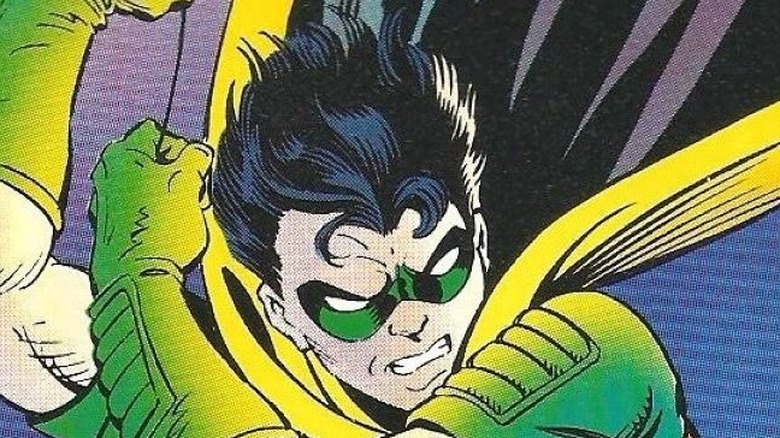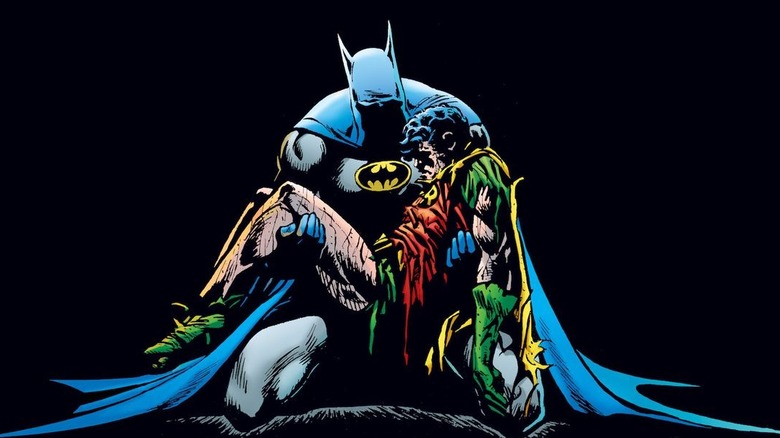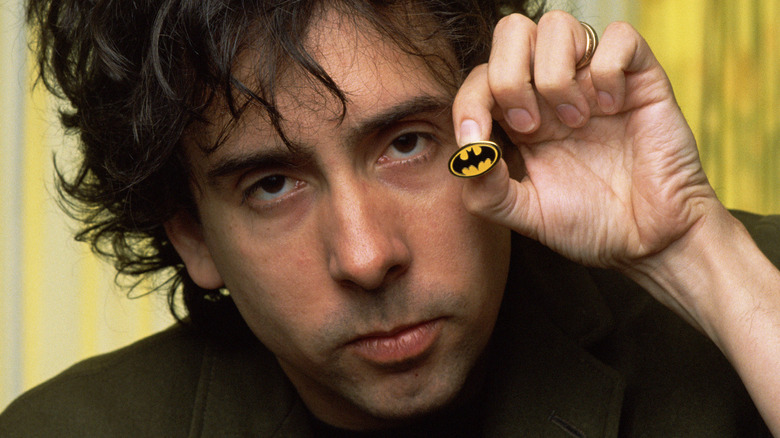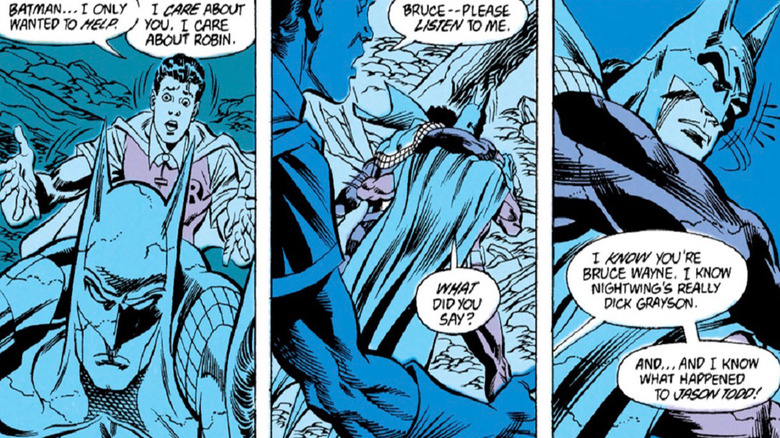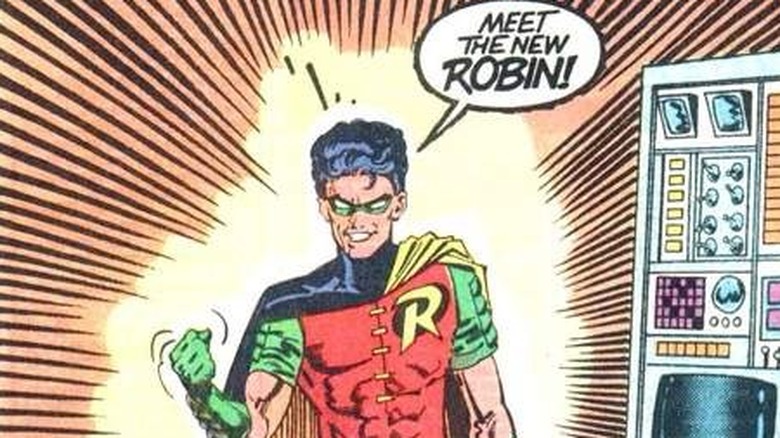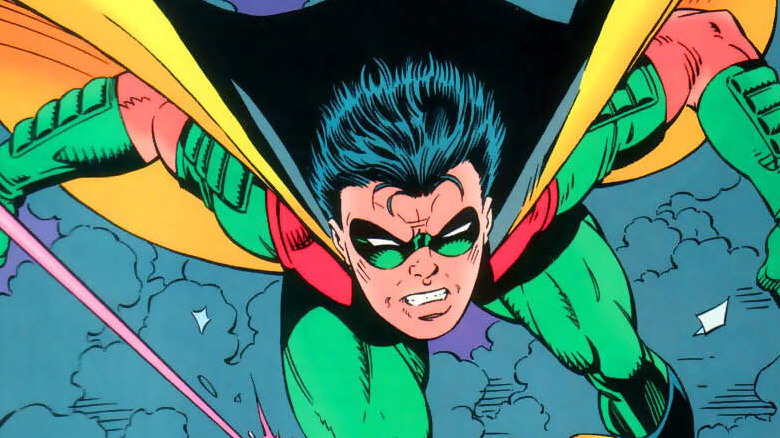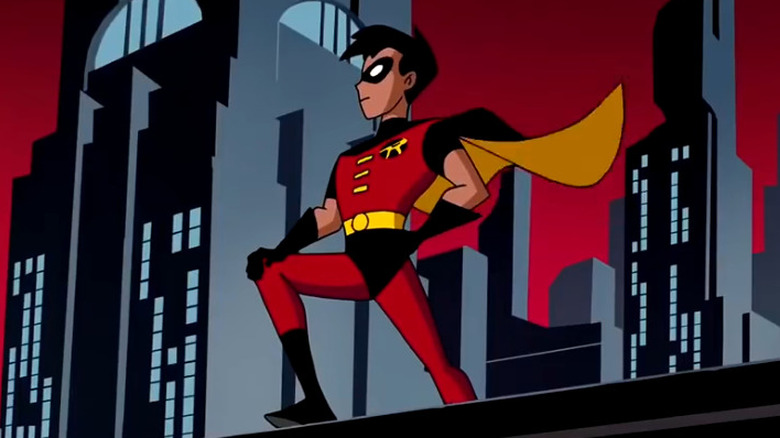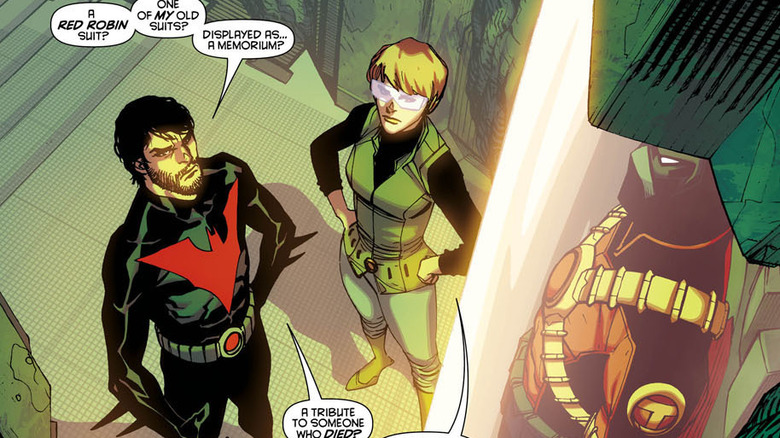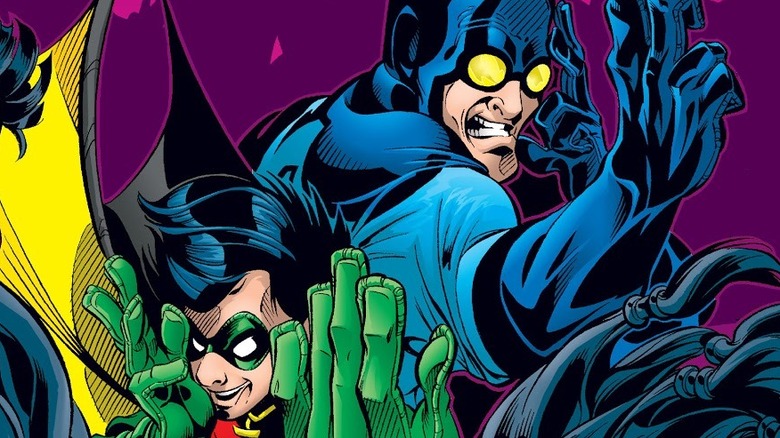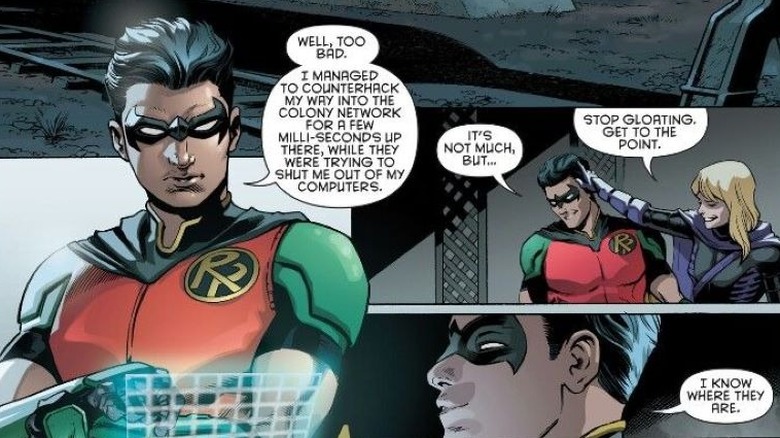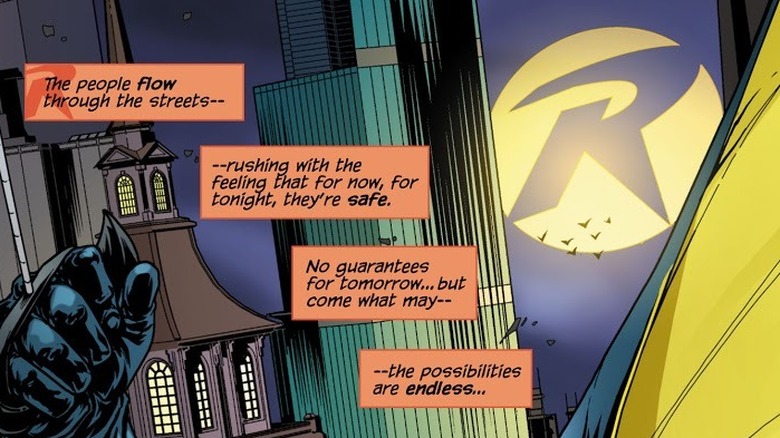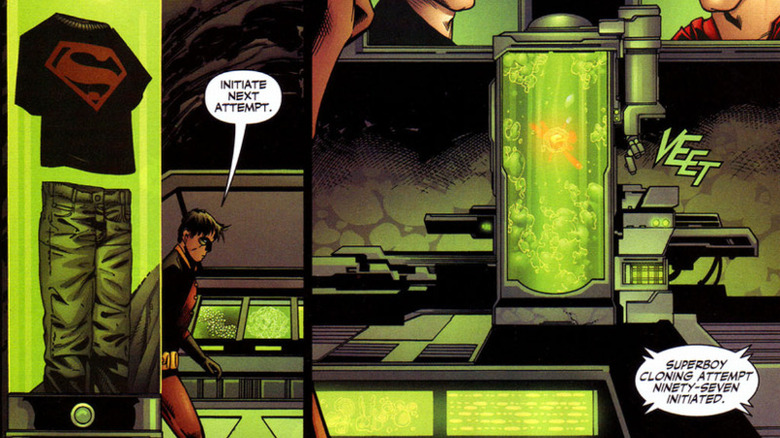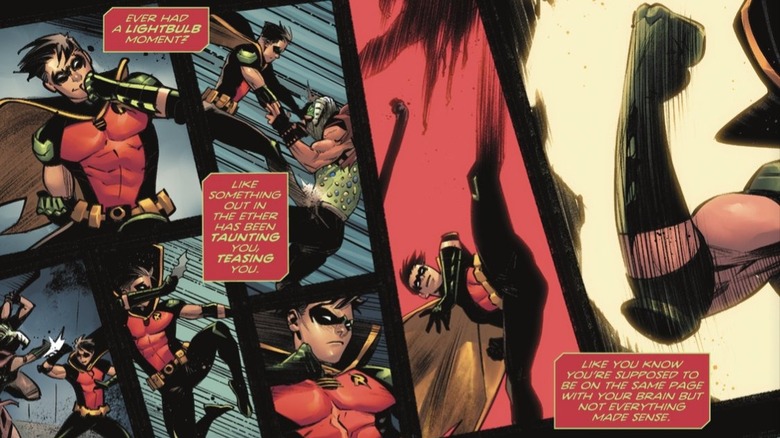The Untold Truth Of DC's Third Robin, Tim Drake
When "Detective Comics" #38 hit comic book stands in 1940, its cover had two surprises for fans of the masked adventurer known as Batman. First, the Dark Knight was looking directly at the reader and smiling, a radical departure from the stone-faced, Zorro-inspired hero introduced just 11 issues earlier. Second, and perhaps more importantly, the crime-fighter was sharing the spotlight with an acrobatic boy in a colorful costume: Robin, a character destined to become an integral part of Batman's mythos.
For decades, readers followed the career of the first Robin, Dick Grayson. However, in an attempt to return Batman to his darker roots, creators began writing the younger half of the dynamic duo out of the Bat-books in the 1970s. DC quickly realized that this was a mistake: Batman must always have a partner. This resulted in the creation of the second Robin, Jason Todd, in 1983. Sadly, he was killed off just five years after his debut, a decision made by readers through telephone voting (via DC Comics).
Since then, many others have taken up the mantle of Batman's sidekick, including his own son and an alien starfish. Arguably, though, no Robin has been as worthy of the title as Timothy Jackson Drake. Here is the untold truth of DC's third Robin, and why some consider him the best Robin of all.
Tim Drake was created to quickly replace the second Robin
Hardly a year after Jason Todd's death, DC was already eager to introduce a replacement Robin. In an interview, former Batman editor Denny O'Neil shared that even he wasn't expecting the quick turnaround: "After we bumped off Jason, I thought eventually, we'd need a new Robin, but I thought we'd give it a year ... But word came down from on high — I mean, higher than [then-DC president Jenette Kahn] — no, we need a new Robin right away."
At the time, it seemed like Jason's rebellious attitude was the reason why readers didn't really warm up to him. According to Marv Wolfman, Batman writer and Tim's co-creator, this may have been because fans in that particular time period didn't appreciate a "snotty, possibly criminal Robin" tagging along with Batman.
Fortunately, when he and artist Pat Broderick introduced Tim in the pages of "Batman" #436, the character appeared to resonate with fans quite well. Bruce Wayne's third protégé had neither the acrobatic prowess of Dick nor the rough edges of Jason; perhaps this is exactly what helped solidify the character's success and make him a mainstay in DC continuity, despite his late introduction into Batman's world.
Tim was named after the director of 1989's Batman
According to Comics Alliance, Wolfman and Broderick named the new Robin after Tim Burton, director of "Batman" (which premiered in 1989, the same year as Tim Drake's debut). Interestingly enough, based on the account of Tim's main costume designer, the Batman films may have been part of the reason Tim was created in the first place.
In an interview with ComicBook.com, legendary creator Neal Adams revealed that both DC Comics and Warner Bros. saw cinematic potential in the Boy Wonder. The film production company was eager to capitalize on the groundbreaking success of "Batman," while the comic book publisher wanted a newer, more practical suit than "that silly costume with the bare legs." Adams came up with the idea of making the yellow cape black on the outside, as well as including ninja boots, pouches, and (thankfully) pants. However, the final version of Robin's chest logo — and the idea of him using a bō staff as his primary weapon — came from a different artist, Norm Breyfogle (via 1989Batman.com).
Curiously, plans to introduce Robin into Burton's "Batman" continuity were reportedly scrapped by the director himself, according to Nerdist. After realizing that "Batman Returns" already had too many characters to juggle, he removed Robin — originally set to be portrayed by Marlon Wayans — from the script.
Tim earned the right to be Robin
The challenge of creating a legacy comic book character lies in making the new person as compelling as their predecessors without turning them into a rehash of everything that worked before. In that regard, Tim successfully sets himself apart from Dick and Jason due to one simple reason: He actually deduces the identities of Batman and Robin through some good, old-fashioned detective work. Wolfman explains that he sought to create a Robin who was smart enough to do "what adults couldn't."
To accomplish this, some retroactive continuity writing, or retconning, was necessary. Tim's comic debut placed him at the final performance of the Flying Graysons, meaning that he witnessed how the first Robin's parents died. Since this traumatic night was burned into Tim's memory, the ill-fated performance came back to him when he saw television footage of Robin pulling off an acrobatic stunt exactly like Dick Grayson had many years ago. This enabled Tim to connect the dots and discover not just Robin's secret identity, but Batman's as well.
For years, Tim decided to keep his deductions a secret, watching the vigilantes from afar. However, he noticed some drastic changes in Batman's behavior soon after Jason's murder at the hands (and crowbar) of the Joker. Recognizing that the Dark Knight needed a guiding light, Tim reached out to Batman and Dick Grayson (who had since become Nightwing), revealed that he knew who they were, and volunteered to be the new Robin.
Tim had to train harder than his predecessors
Tim Drake has proven that he possesses the deductive chops to partner with the World's Greatest Detective. Additionally, he doesn't have a tragic family background like Dick or Jason, which arguably makes him a more emotionally stable candidate for the position. Developing the actual combat skills and physical prowess of a worthy crime-busting companion, however, is an entirely different matter.
Despite undergoing some martial arts and acrobatics training before he even turned 13, Tim doesn't assume the role of Robin immediately upon joining the Bat-Family: Batman certainly doesn't want to risk sending another child soldier off to his potential death. In order to avoid having another partner die on his watch, Bruce subjects him to a period of intense training, more than any of the previous Robins received. This includes meeting and learning under various martial artists in different parts of the world.
According to O'Neil, the creative team intentionally kept Tim out of costume (and thus out of danger) for several months after his debut, relegating him to the less-perilous role of "the guy who did reconnaissance from across the street." It was Bruce himself who finally presented Tim with his new costume after the latter used his skills to help defeat the Scarecrow. Thus, when Tim officially became the new Robin in the final pages of 1990's "Batman" #457, the moment felt like one the character had truly earned.
Tim was the first Robin to get a solo series
Since the character's debut, Robin has been featured in a wide variety of comic book titles. Apart from his appearances in "Detective Comics" and "Batman," the Boy Wonder popped up in the Superman-Batman team-up book "World's Finest." Dick was a co-founder of the Teen Titans, a team formed in the pages of "The Brave and the Bold" #60. Meanwhile, Jason appeared in some noteworthy stories outside of the Bat-titles during his brief tenure as Robin, including the critically acclaimed "For The Man Who Has Everything" in "Action Comics Annual" #11.
However, it was Tim who first starred in a solo "Robin" comic book. The first volume was a 5-issue limited series published in 1991, while the second was ongoing, running from 1993 to 2009 with nearly 200 issues. The second volume sprang from the events of the "Knightfall" crossover event, in which an incapacitated Bruce Wayne chose a violent successor to temporarily replace him as Batman: This prompted Tim to move out of the Bat's shadow and start having solo adventures.
So, how did Tim manage to not only become his own hero, but also find commercial success headlining his own book? As Fabian Nicieza explained: "I think new readers were taken by Chuck Dixon's take on the character ... which very smartly combined aspects of 'the making of a hero' arc with 'teen angst' that wasn't too dour, but gave Tim conflict in a fun way."
Tim's first cartoon appearance wasn't exactly source-accurate
Ask any '90s comic book fan to name their favorite cartoon, and there's a good chance they'll say it's "Batman: The Animated Series." It's one of the most recognized modern animated takes on the character, kicking off an entire shared continuity of DC cartoons called the DC Animated Universe. Its follow-up series, "The New Batman Adventures," featured Tim Drake's animated debut. However, it didn't really feel true to the character at all.
Tim first shows up in the 1997 episode "Sins of the Father," replacing Dick Grayson (who had a falling-out with Batman) as Robin. However, this version isn't a direct adaptation of Tim from the comics; in fact, he feels a lot more like Jason Todd, from his tragic family background to his overall attitude and temperament. This Tim, however, demonstrates the comic book version's exceptional powers of deduction and proves to be a worthy member of the Bat-Family.
However, while he does manage to escape Jason Todd's fate, he doesn't exactly get out of his life as Robin unscathed. The 2000 animated film "Batman Beyond: Return of the Joker" reveals that the Joker, now deceased, placed a DNA microchip into Tim's spine when he captured the Boy Wonder many years ago. The chip triggers when Tim becomes an adult, turning him into the new Joker. The Batman of that era (Terry McGinnis) fights him, successfully freeing the former Robin from the deceased villain's grip.
Tim succeeded two different Batmen
Throughout his comic book career, Tim has taken on a number of other identities. During a time when Bruce Wayne is presumed dead, Tim assumes the mantle of Red Robin, complete with a darker costume. For a time, he also calls himself Drake (though that, and the brown costume that comes with it, doesn't last long). Unsurprisingly, Tim has also donned Batman's cowl on more than one occasion — and not just the Batman of the present.
In the story "Titans Tomorrow" (from "Teen Titans" #17-19), a possible future shows the Teen Titans eventually replacing their mentors, employing more violent means to achieve their ends. At the forefront of this future team is the grown-up version of Tim Drake, who becomes Batman after Bruce Wayne's death. As Batman, Tim is far more ruthless than his adoptive father, completely doing away with his predecessor's "no killing" code. He even uses a gun, a radical departure from the original Batman's methods.
Tim also briefly replaces the Batman of the year 2039, Batman Beyond. In a time-hopping story, a version of Tim who has lost all his Titans teammates in a brutal war is thrown 35 years into his future. A series of events leads to Tim adopting the Batman identity and becoming Neo-Gotham's guardian. When it's revealed that the first Batman Beyond, Terry McGinnis, is still alive, Tim surrenders the mantle and retires for good.
Tim actually idolizes a different superhero
Given that he's Batman's sidekick, it's reasonable to assume that the Dark Knight is Tim Drake's favorite superhero. However, a few comic book stories reveal that this isn't quite the case. Tim actually looks up to a different masked adventurer — one who isn't exactly popular with the rest of the spandex crowd. In fact, if things had gone the way writer Chuck Dixon had originally intended, Tim would have become his superhero idol's successor.
Ted Kord, the high-tech superhero called Blue Beetle, first appeared in 1966 under a different publishing company, Charlton Comics. He was one of many characters integrated with DC when it acquired Charlton about two decades later. In an early 2000s story in "Birds of Prey," Tim teams up with the cerulean crusader, admitting to Ted that he's been a fan for quite some time.
At the end of the story, it's hinted that Ted might need to retire, planting the seeds for a replacement — namely, Tim — to step in. As Comic Book Resources revealed, "The idea was that, for whatever reason, Tim would quit as Robin ... and become the new Blue Beetle under Ted Kord's guidance. This would involve a six-issue Blue Beetle mini-series starring Tim and Ted, and after it was all over, some crisis or another would drag Tim back to being Robin." Unfortunately, DC turned down the proposal more than once.
Tim is canonically the smartest Robin
As Batman's partner, Robin aids in the Caped Crusader's exploits with a unique set of talents, depending on who's under the domino mask. Dick Grayson complemented Bruce's abilities with his expert-level acrobatic prowess and people skills, while Jason Todd was a courageous brawler who was never afraid to get his hands dirty. In Tim's case, he offered his incredible mind and technological expertise. Many Bat-allies (and even Bat-foes) consider him the most intellectually gifted person to don the cape and tights.
According to Screen Rant, Tim initially makes up for his lack of intensive combat training with his analytical brain: He was solving crimes way before he became Batman's ally. In addition, he's a computer whiz on a level close to the Bat-Family's resident tech expert, Barbara Gordon aka Oracle. Tim bypasses high-tech security measures without breaking a sweat, hacks enemy technology with ease, and is better at computers than even Batman himself.
Perhaps the best evidence of Tim's incredible intellect, however, is the compliments he's received from both Batman and longtime villain Ra's al Ghul. Ra's has referred to Tim as "detective," a title the international terrorist previously reserved only for Batman. Meanwhile, Bruce has stated, plain and simple: "Tim Drake has the best tactical mind of any partner I've worked with."
For a short while, Tim had a Robin-Signal
Given how some future versions of Tim end up becoming Batman, it's fascinating that among the Robins, he's the one least interested in replacing Bruce Wayne. In fact, when he has the opportunity to succeed his presumed-dead mentor, he not only passes on the chance, but also fights to preserve the integrity of one of the Bat's most famous symbols.
During 2008's "Final Crisis," Batman seemingly dies at the hands of the intergalactic despot Darkseid. During Batman's absence, Gotham's police department recognizes Tim's efforts in protecting the city. Thus, in "Robin" #182, Commissioner Gordon has the Bat-Signal replaced with a "Robin-Signal" bearing Tim's insignia. Tim appreciates it, but has it changed back to the Bat-signal the very next issue, as he knows Batman's presence has a powerful psychological effect on Gotham City's criminals.
But the cowl still calls to Tim: In order to stop a resurrected Jason Todd from taking up the Bat-mantle and tarnishing Bruce's legacy with his use of guns, Tim reluctantly suits up as Batman to take him down. He loses the battle against Jason (and nearly his life) until Dick saves him. Dick then becomes the new Batman, and since he respects Tim's abilities enough to see him as more than a sidekick, he chooses Bruce's son Damian to be his Robin. Tim subsequently takes on a new identity: Red Robin.
Tim tried to clone his best friend 99 times
One of the DC universe's strongest and most enduring relationships is the friendship between Tim and Conner Kent aka Superboy. A clone made up of DNA from both Superman and Lex Luthor, Conner becomes a member of the Teen Titans, developing a strong bond with Tim. When Conner dies fighting an incredibly powerful threat during the "Infinite Crisis" event, a grieving Tim feels that the only way he can keep going is if he brings his best friend back to life — even if it means going full mad scientist.
Some time after Conner's death, his girlfriend Wonder Girl (Cassie Sandsmark) discovers Tim's dark secret: He has actually been trying to bring Conner back to life by cloning him in a hidden laboratory, failing 99 times due to the inherent complexity of cloning someone with Kryptonian DNA. Few deaths stick in the realm of comic books, though, and Conner does eventually come back to life and is reunited with his best friend.
Tim's bisexuality has been hinted at for years
Released in 2021, "Batman: Urban Legends" #6 contains the conclusion of "The Sum of Our Parts," in which Tim Drake realizes his bisexuality. While this may have come as a shock to new readers, many longtime fans of the third Robin weren't surprised.
According to Screen Rant, this moment is a culmination of decades of clues about Tim being queer. For starters, his bond with Superboy is shown to be deeper than most fictional friendships; Tim and Conner occasionally find themselves in exchanges that seem to hint at something "beyond the realm of friendship." There is also a scene in 2003's "Titans/Young Justice: Graduation Day" in which Tim and Conner change clothes inside a closet. When asked about it on Twitter, writer Judd Winick humorously replied that he "saw this as an opportunity for them to both come out of the closet." Additionally, during a period of time when Conner is erased from existence, Tim acknowledges that the name Conner tugs on his heart, though he can't quite remember why.
One thing is certain: Tim's revelation provided him with a much-needed sense of clarity, allowing him to know himself better — and likely become an even better superhero.
